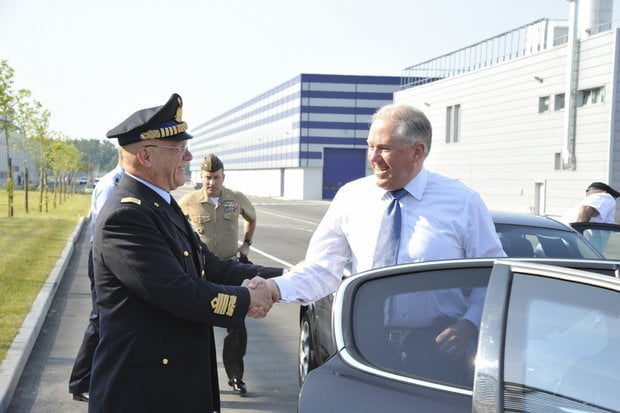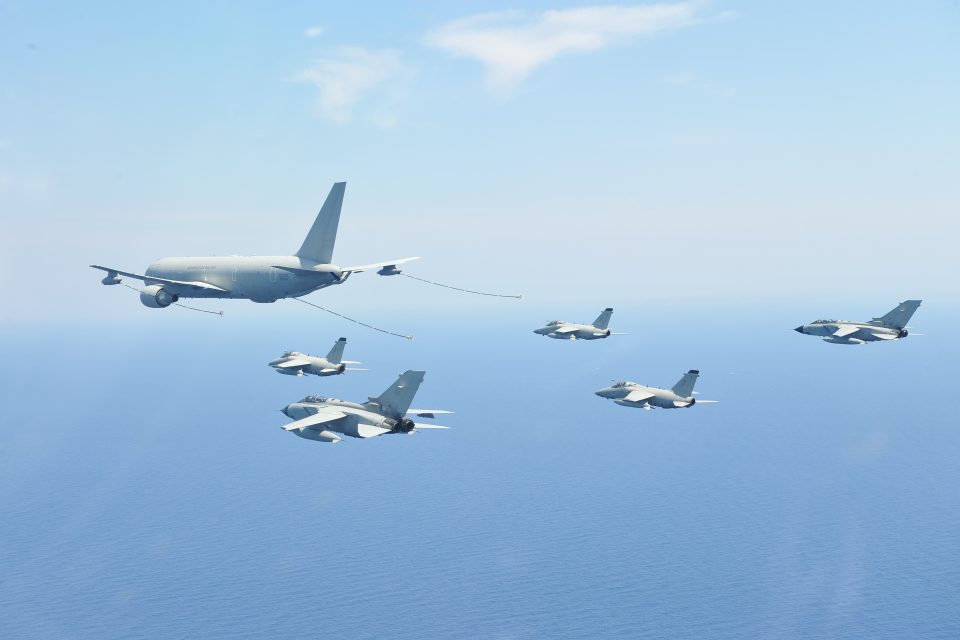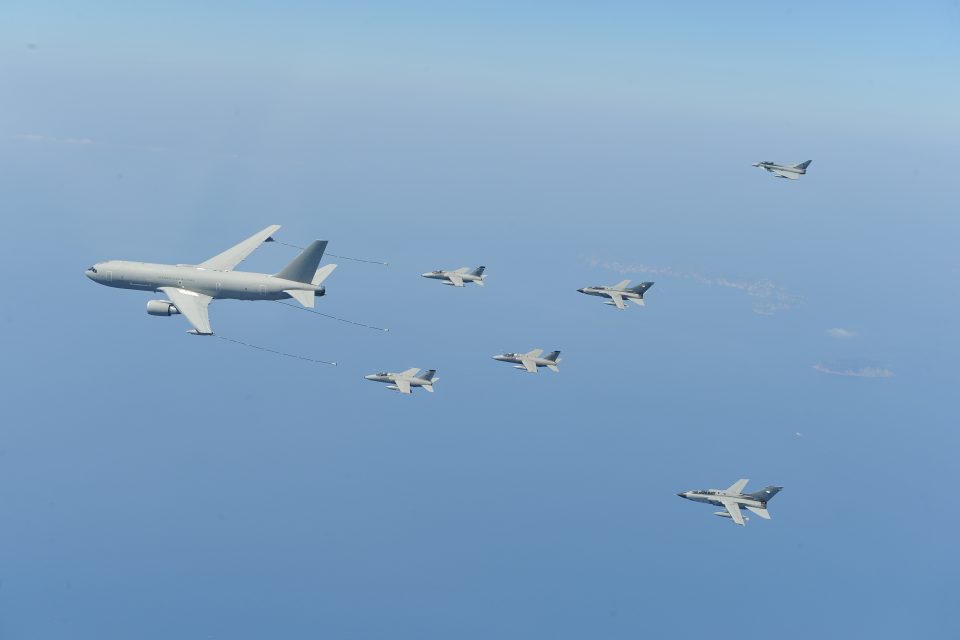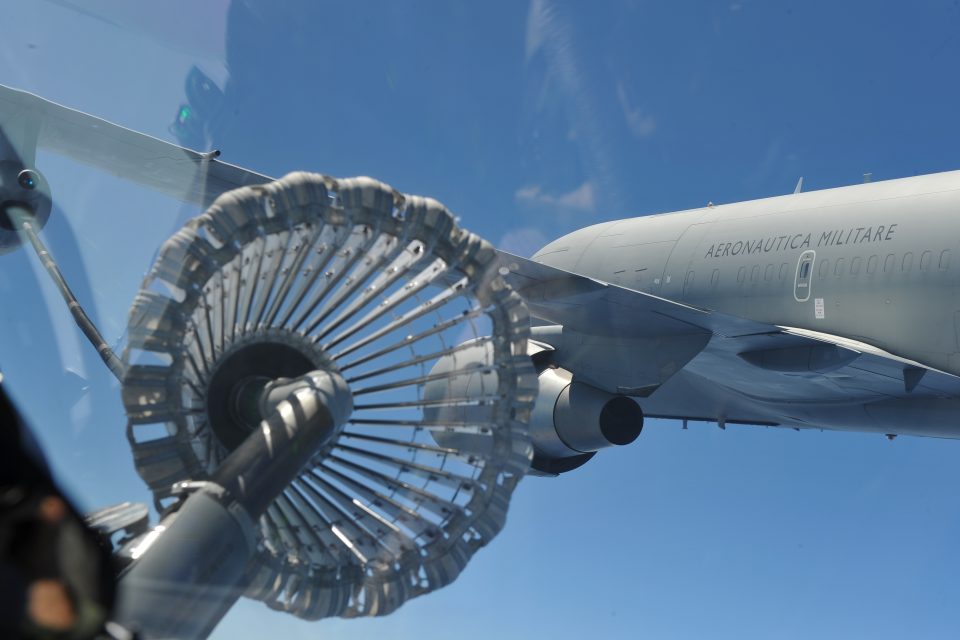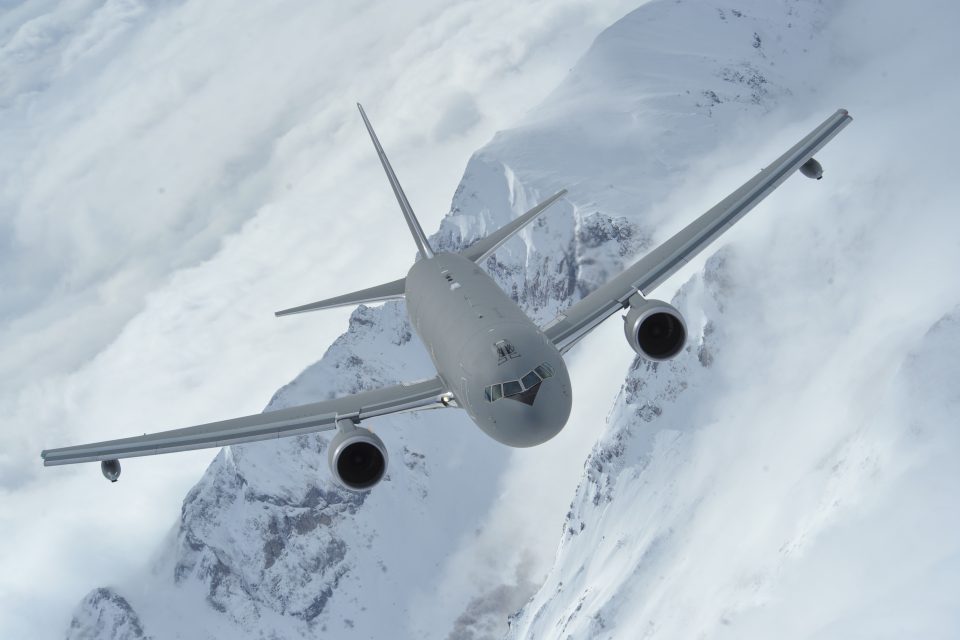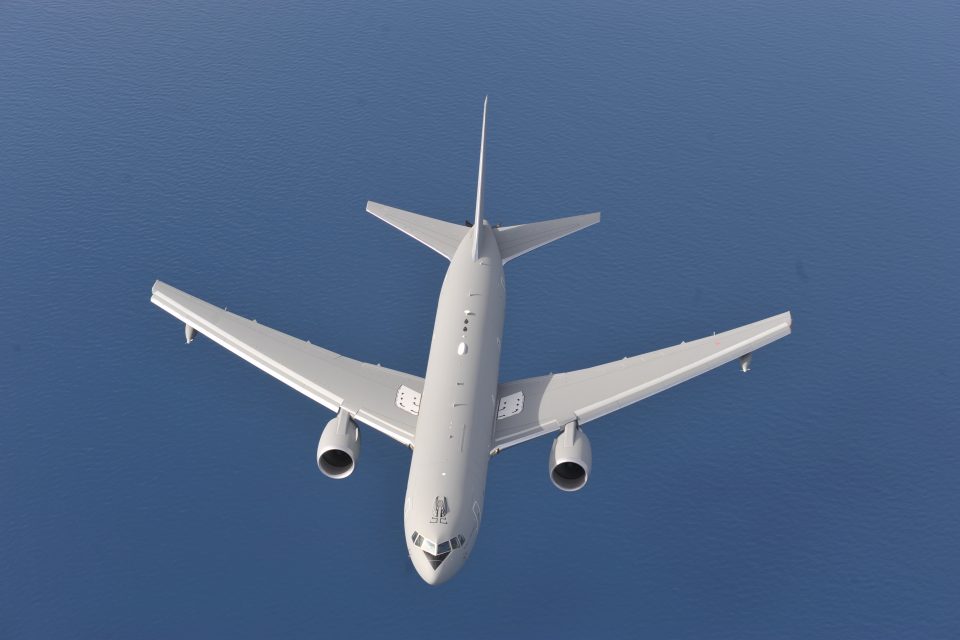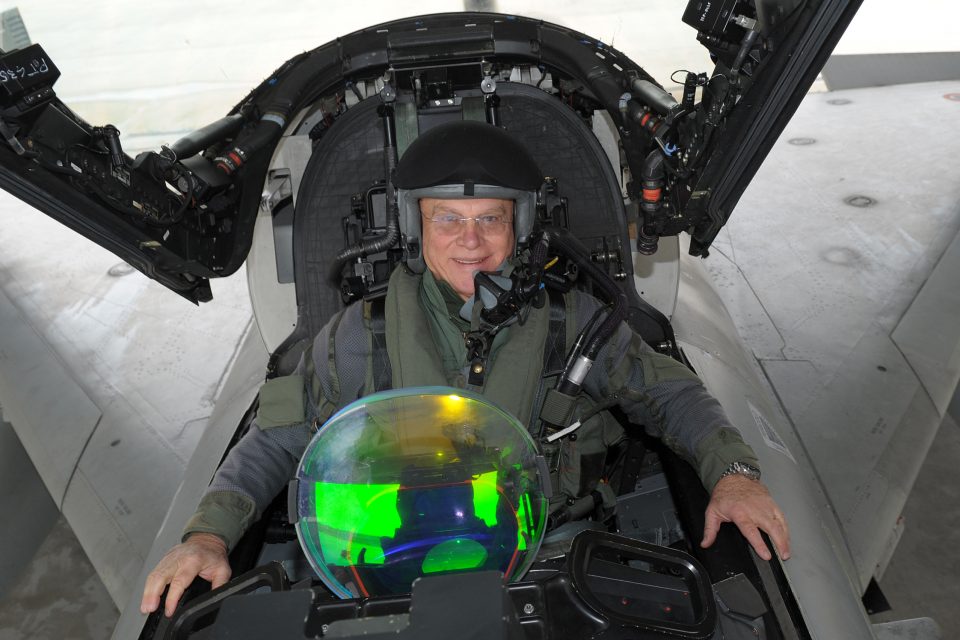2014-10-17 By Robbin Laird
It has been a year since I first sat down with Lt. General Preziosa at his office in Rome to discuss the evolution of Italian and coalition airpower.
I had a chance to both discuss with the COS of the Italian Air Force at a meeting in his office on October 1, 2014 and then to listen to him present at a seminar held by Airpress in Rome on October 3, 2014.
At that session, my colleague Air Vice Marshal (Retired) John Blackburn and I presented a joint briefing on how to prevail in 21st century conflicts and the practical approaches, which the USMC and the RAAF are taking to deal with these conflicts.
After our brief, Lt. General Preziosa presented at the Seminar and engaged both of us in terms of the presentation and addressed the broader audience about the future of air and space power.
This article draws upon both the office meeting and the public presentation to provide a sense of how Lt. General Preziosa looks at the evolving threats to Europe and ways to shape responses in a fiscally challenging environment where insecurity in the strategic environment is on the rise.
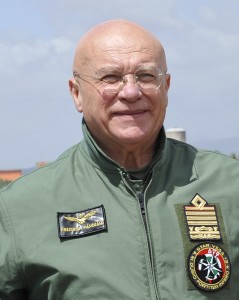
While I was in Rome, the debate over the F-35 program continued, with the lines drawn between those who wished to cut the program (its elimination is no longer on the table in practical political terms) and those who want to leverage it for overall force transformation within Italy and as a means to enhance coalition collaboration and combat power.
During our discussion last year, Lt. General Preziosa discussed at some length the F-35 and its role in Italian and coalition defense. This time we focused on the evolving strategic context and the role of air and space power as providing crucial means to allow Italy to defend its interests and to work more effectively with allies.
During the Seminar, the COS discussed the F-35 directly in response to the presentation of Air Vice Marshal (Retired) Blackburn who had focused upon the RAAF approach to leveraging the F-35 acquisition to generate a force transformation effort.
This effort labeled as Plan Jericho was clearly an approach with which Lt. General Preziosa found congeal to his own thinking about the way ahead for Italian airpower.[1]
The Context
Italy in common with other members of the Euro zone is in the midst of a financial crisis. This crisis is fundamental and puts real pressure on the ability of governments to govern effectively and to shape a way ahead economically. This as well puts pressure on defense, foreign and security policy by reducing the means available to deal with external crises as well as forcing very difficult trade offs for decision-makers and government strategists.
As Preziosa put it: “Maslow’s first need must be met in order to deal with the second need. That is to say providing for the basics of life is crucial in order to enable citizens to be engaged in the broader challenge of providing for their security.”
Yet while the Euro Zone countries are sorting through ways to navigate the economic crisis, the crisis zone around Europe has heated up.
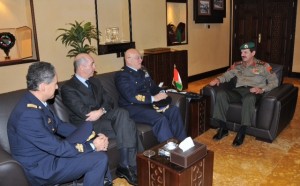
And because the crises which Italy and Europe are facing are not as “geopolitically focused as during the Cold War, there is a difficulty to identify the nature of the threats and how best to respond.
There is threat confusion and lack of clarity which create challenges for leaders to define the most effective ways to approach dealing with external crises while dealing with the fundamental economic one.”
“Instability is increasing around us; and questions we thought were closed open up again. We do have a financial crisis, but the instability which threatens us also affects that crisis and needs to be dealt with as well.”
Preziosa characterized the nature of the crises facing Europe and the industrial democracies in three key ways.
First, “strategic surprise is becoming a norm for governments to deal with.
This makes the preparation for dealing with the strategic surprise difficult and assembling the means and shaping an approach also difficult.”
Second, there is a global quality to the threat facing the industrial democracies.
“Terrorists do not travel on the passport of the country for whom they really fight. They use those passports to generate resources and ways to promote their ideologies. Obviously, terrorist organizations need money, recruits and arms. And they operate from territories, so that although global they operate locally. And when they operate locally that is when they provide the targets against we can act.”
He added: “Terrorists act without boundaries; we need to not be constrained by boundaries either in dealing with them as a threat. Sharing of information and intelligence is important for the industrial democracies.”
Third, he also focused on what he believed was the relative agility of the information networks of terrorists.
“Western democracies have a ponderous intelligence gathering and assessment system; terrorists do not; and they act rapidly based on what they believe to be the relevant information or intelligence. This means that we have a gap as well with regard to having the core information and intelligence within which to act rapidly.”
It is also the case that Western democracies will react not act.
“We are not proactive; we respond to threats when they become very evident. This puts a premium on the ability to act quickly when the threat is recognized and the need to respond agreed upon.
Put in other terms, proactive mindset would allow one to shape forces and power approaches to provide for a shaping capability to prevent crisis; but by and large, democracies naturally follow a process that does not allow for that kind of proactive engagement.”
The Approach
Strategic surprise coupled with the difficulty for democracies to shape strategic environments or to react quickly means when decisions are taken to engage force, those forces need to be able operate rapidly. And the need to operate with coalition partners, to share risk and cost, also places a challenge on national forces in engaging against threats.
Preziosa argued that the central role of air and space power really flowed from the nature of the operational environment embodied in the above paragraph.
“Only air and space power have the flexibility, speed and reach” to enable democratic leaders to insert force rapidly enough to make a difference.
By air and space power the General clearly meant both the nature of these capabilities in and of themselves, and as enablers of air, ground, and sea power.
“Air and space power are the backbone of shaping the forces able to operate effectively enough to deal with the strategic surprises and rapidly of threat developments which we face.”
An example of the nature of the threat, which he provided, was that of ISIS. When he visited Kuwait earlier this year, ISIS had about 3,000 followers. He was told that this threat was capable of being handled by normal military means. But rapidly ISIS has become more than 30,000 followers and is making military impacts with equipment seized in Iraq and leveraging the money of seized oil fields.
All of this happened rapidly and requires creating a response capability in the flow of events AFTER the terrorists have passed crucial mass.
With regard to terrorists, Preziosa argued: “if you can avoid them one should do so, but when in contact with them there is no alternative but to neutralize them. Committed terrorists are not going to be drawn from their cause.”
But the use of force against “surprises” needs to be calibrated with a clear understanding of goals and objectives, and what can be achieved.
Conflict termination concepts need to be married with the use of force.
“We need to think through what is realistic for us to accomplish. We need a clear sense of what end states are realistic and those that are not. And the complete elimination of terrorism, as an assigned end state for air power intervention, is beyond our means. What we can do is to reduce the direct threat and to that with attacking them as they become mobile and work to seize the territory from which they hope to operate, govern or leverage economic assets, like oil fields.”
The Way Ahead
Dealing with strategic surprise and 21st century threats means that we need to have forces up to and relevant to the challenges.
“To be effective today democratic political and diplomatic power needs to have instruments which are flexible, agile, credible and scalable.”
Because of the limits of economic resources, shaping and sustaining such forces is a challenge, which means that we have to think in terms of cost effectiveness when working with coalition partners.
“The cost of a fully modern 21st century force that democracies need is beyond even the reach of the richest industrial democracy. We need to share in terms of capabilities, and in order to do so we must ensure that these forces can work effectively together.”
Modernization is essential and Preziosa sees somewhat similarly to Air Marshal Brown of the RAAF, the opportunity to leverage the F-35 as a transformation asset.
“We need to think beyond the F-35 as a platform, and to think of the overall system capabilities, and in this case the system of systems within which modern combat forces are designed, built and employed.”
And the heart of the transformation is to achieve “an effective C4ISR enterprise within which the forces can operate with information superiority. Because we deploy only relatively late, our forces need to be much more effective in being linked together to provide for information superiority.”
For Preziosa, an effective C4ISR enabled force is one, which can be used “to intervene as rapidly as possible with the greatest effectiveness possible.
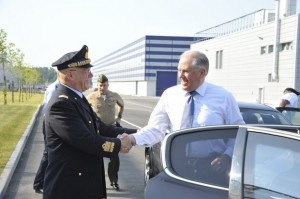
By so doing, one can reduce the escalation of the conflict.
Airpower provides crucial tools to control the fire and reduce its threat to spread (deterrence nature of air power).”
He highlighted the important of fusing information and delivering appropriate information to the right level of combat action or decision-making.
For Preziosa, again not unlike the RAAF leadership, the F-35 needed to be part of what he called “a fifth generation communication architecture” capability whereby the air enabled ground and naval forces can work more effectively with one another to concentrate on opponents Centre of Gravities, i.e. “strategic surprises” which are coming in the pop-up strategic environment of the 21st century.
The Chief of Staff used a simple analogy to explain the situation.
“You secure your apartment against those who would seek to steal from you. You do not know the name of the burglars or what means they will use, you just know they might come. And you need to prepare your defense.”
In both the office meeting and the seminar, Preziosa underscored the importance of air and space power to enable the democracies to defend their interests in dealing with “strategic surprises,” but there is a clear need for leaders to define what can and cannot be achieved by such actions.
In other words, he underscored what I like to call the necessity for fairly clearly defined conflict termination strategies and managing expectations of what can be achieved through a military operation. In effect, he highlighted that we can attenuate a threat from terrorists, not completely eliminate it; but do nothing will only see the threat become much larger.
“And to act too late, or too little will hardly save resources for then we will have to shape a much larger response or choose to do nothing at all.”
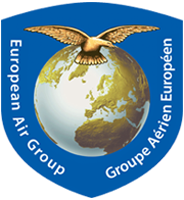
Working within a coalition is central for Italy. Indeed, with regard to the F-35, it is as a coalition aircraft that the Italian Air Force and Navy are players in the program and with a clear expectation that allies will share in the sustainment of coalition fleets, as it will operate in future contingencies.
Preziosa highlighted two other important sharing efforts in Europe, which are designed to enhance capability. “The point of sharing is not simply to share; it is to shape a greater capability to act and with greater and more effective means.”
The first is Italian participation in the European Air Group, located at High Wycombe in the United Kingdom.
Here Italian Air Force aircraft – such as the Tornados and Eurofighters – work to be more effectively integrate in coalition operations, as happened with the UK and Italy operating from an Italian base during operations during what the US called Odyssey Dawn.
The second is Italy entering into the European Air Transport Command (EATC) and committed to EPRC (European Personnel Recovery Centre).
“We are contributing our transport aircrafts and new tankers to the EATC”. Besides Italy is engaged with EAG nations to establish a Personnel Recovery (PR) Centre, based in Italy, in 2015. This centre is addressing a very important operational function (PR), in order to foster joint-combined interoperability through common approaches and common procedures, under a lead service approach. I believe those are simple and tangible examples of what is commonly known as pooling & sharing initiatives.”
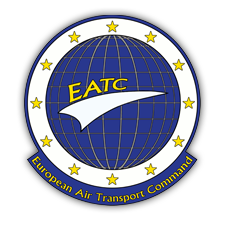
Italy also performs a number of NATO air policing functions, which are not widely recognized outside of Italy. With Greece, Italy provides air policing for Albania. For Slovenia, Italy provides air protection for that country. And Italy provides rotational support for the Iceland and Baltic air policing missions as well.
As we deal with “strategic surprises” in the period ahead, the industrial democracies will face the challenges of force modernization, effectively use of forces, shaping more capability for effective conflict termination and better coalition interoperability and collaborative con-ops.
These are major challenges but central ones to the way ahead as viewed from the perspective of the Chief of Staff of the Italian Air Force.
He concludes that “airpower needs broader and more effective public support; we need to do a better job of explaining the direct relationship between effective airpower – notably in coalition – and the ability of the democracies to defend our values and way of life.”
Background:
European Air Group (EAG)
The European Air Group (EAG) is the only independent Air-minded organization in Europe. It comprises the Air Forces of 7 European nations: Belgium, France, Germany, Italy, the Netherlands, Spain and the United Kingdom. The EAG has links with many other organizations and nations.
The EAG undertakes projects and studies in order to identify realistic ways to improve the interoperability between member nations.
http://www.euroairgroup.org/project/european-personnel-recovery-centre-eprc/
European Air Transport Command (EATC)
On 1st September 2010 a new chapter in the book of European Security and Defence Policy (ESDP) was opened, as the EATC was inaugurated in Eindhoven, the Netherlands.
The establishment of this new multinational command represents a significant step on the way to pooling and sharing national military assets and truly marks an unprecedented level of European defense cooperation.
The Netherlands, Belgium, France and Germany have put major parts of their air transport- and air-to-air refueling fleets under the operational control (OPCON) of the EATC. On 22 November 2012 Luxembourg officially joined the EATC, Spain followed on 03 July 2014.
Now the missions of almost 150 aircraft are planned, tasked and controlled out of Eindhoven. In addition to that the EATC runs a nationally defined level of responsibility for aircrew training, coordination of training and exercise objectives as well as the harmonization of appropriate air transport regulations of the participating nations. The overall objective is to manage the scarce resource air transport as effectively and efficiently as possible.
Italy and the EATC:
It was an open secret for some time now, until Italian Air Chief Lieutenant General Pasquale Preziosa sent a formal letter asking for Italy to join the European Air Transport Command. The letter marks the first formal step on Italy’s way to become a full member of the EATC organization – in accordance of the “EATC Enlargement Principles and Procedure”.
LTG Preziosa mentioned that “a broader Pooling & Sharing implementation of Air Transport and Air to Air Refueling assets in Europe would be beneficial to the whole (European Air Transport-) community, bringing together national assets, human resources and valuable expertise”.
As a next step, the Italian AF Staff will present in a formal written document to the MATraC – the Airchiefs committee of the EATC Participating Nations – Italy’s Air Transport, Aero-medical Evacuation & Air-to-Air Refueling (AT, AE & AAR) capabilities and the Italian Air Force’s added value in order to justify a possible membership to the EATC. Based on this document and the recommendation of the Commander of the EATC the MATraC will decide whether to start the assessment process.
The assessment will help to evaluate the fulfillment of requirements and criteria. After a successful assessment the MATraC then may establish a working group to negotiate the detailed terms of accession. Finally, subsequent to the formal invitation of the Candidate State to join the EATC, signatures of legal documents will conclude the accession process and future Italian personnel will take up duty within EATC premises and assets.
http://eatc-mil.com/45/articles/news/153/Italian+Air+Force+about+to+join+EATC
EATC and Air-to-Air Refueling Exercise
31 March 2014
The first ever European Air-to-Air Refueling Training (EART14) taking place at the Eindhoven Air Base in the Netherlands starts today. Between 31 March and 11 April aircraft and crews from Germany, Italy, and the Netherlands will participate in realistic Air-to-Air Refueling training scenarios within a modern air combat environment.
EART14 offers participants a unique opportunity to plan and execute missions within a multinational framework. The exercise has been developed by the European Defence Agency (EDA) in close cooperation with the European Air Transport Command (EATC) and the Dutch armed forces.
Critical force enabler
As most transport and fighter aircraft are not able to cover intercontinental distances in just one sortie, Air-to-Air Refueling (AAR) is a critical force enabler and is a requirement for sustained air combat operations. Despite the importance of AAR, European armed forces have suffered from both a lack of equipment and a lack of interoperability in this field. This has led EU countries to rely heavily on US assets in past operations.
In 2011, Defence Ministers tasked the EDA to propose measures to mitigate the capability gap in European military AAR-matters. The EDA has since developed and implemented a global approach to tackling the shortfall of AAR capabilities, which involves increasing the overall AAR capacity, reducing fragmentation of the fleet, and optimizing the use of assets.
This approach was endorsed by the European Council in December 2014, where Heads of State and Government approved the Agency’s roadmap on AAR.
Dedicated AAR scenarios
Eindhoven Air Base will be used as Tanker Forward Operating Base (FOB) during the exercise period. The exercise will be done in cooperation with the Dutch Frisian Flag 2014 to provide crews with the opportunity to take part in dedicated AAR scenarios embedded in a highly recognized fighter exercise. EART14 will be developed gradually with exercises becoming increasingly complex in nature over the two weeks, starting from single ship missions and evolving to become part of COMAO missions within Frisian Flag.
Background
The EDA has a comprehensive plan to improve the AAR capabilities in Europe. Mandated by Defence Ministers, EDA is engaged in four work strands in this domain: short-term gap filling; optimization of existing assets; optimization of AAR capacity offered by the future A400M fleet and enhancement of Europe’s strategic tanker capability by creating a multinational Multi Role Tanker Transport (MRTT) capability.
As part of this global approach, the EDA, Italy and the Movement Coordination Centre Europe (MCCE) jointly organized the first collective European Air-to-Air Refueling (AAR) clearance trial on the Italian KC767 in September 2013. This enhanced AAR capabilities, as technical and operational clearances are mandatory to provide or receive fuel and they are thus a prerequisite to interoperability in multinational operations. Aircraft from France and Sweden participated in the campaign to obtain technical and operational AAR clearances against the Italian strategic airlift tanker.
The photos in the slideshow were provided by the Italian Air Force.
The first shows the COS in an Italian Eurofighter. The rest of the photos highlight the Italian 767 tanker.
[1] This is how the COS of the RAAF put it in a presentation on May 29, 2014:
- I intend to release Plan Jericho, the RAAF transformation plan, in early 2015. It will guide our force transformation, enabled by our new 5th Gen capabilities, over the next decade.
- I will also be engaging closely with industry in the development of the plan.
- It is the technology that is being developed by industry that affords us the opportunity to transform our force. It is essential that we partner with industry to explore how we can maximize the opportunity offered by 5thGen systems. I ask you to consider how you can work with us, not just at the platform level … but in helping us think through and design our overall future force using the 5th Gen capabilities you develop and will help us sustain in the future.”
https://sldinfo.com/thinking-through-the-future-of-airpower-air-marshal-brown-weighs-in/
Last year’s visit led to the production of a Special Report on Italy and the F-35 which can be downloaded here in either English or Italian:
https://sldinfo.com/cameri-italy-and-the-f-35-special-report/
And for the seminar presentation given by Laird and Blackburn in Rome on October 3, 2014 see below:
For a PDF of this article see the following:
Preziosa Interview October 2014


